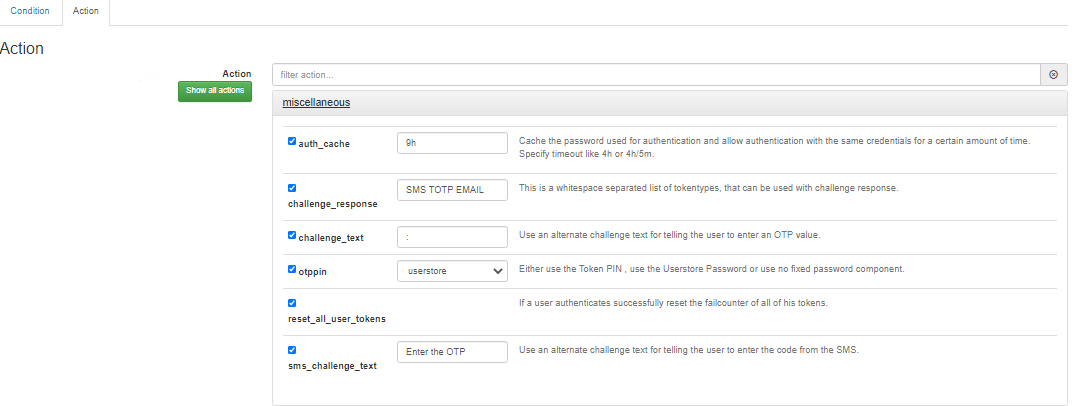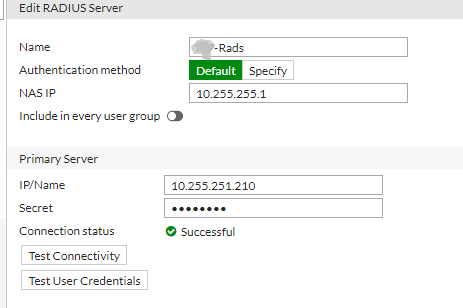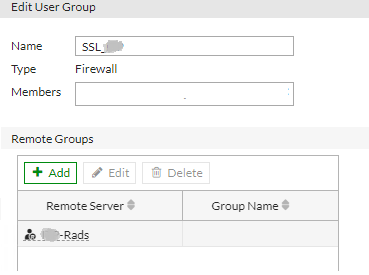Hello,
I would like to link privacyidea and VPN Fortigate with each other. I have set up a radius server on a privacyidea server. I did everything as in the guide: error509.com/2020/05/fortigate-2fa-con-freeradius-y-privacyidea/ When logging into fortigate, the user enters his password and logs in without entering the token required. In debug mode on radius I have this message:
(0) Received Access-Request Id 187 from 10.200.1.254:24054 to 172.20.17.171:1812 length 136
(0) NAS-Identifier = “eulc”
(0) User-Name = “testoweradius”
(0) User-Password = “XXX”
(0) NAS-IP-Address = 10.200.1.254
(0) NAS-Port = 1
(0) NAS-Port-Type = Virtual
(0) Called-Station-Id = “10.200.1.254”
(0) Calling-Station-Id = “172.20.20.10”
(0) Acct-Session-Id = “49df5f47”
(0) Connect-Info = “vpn-ssl”
(0) Fortinet-Vdom-Name = “root”
(0) # Executing section authorize from file /etc/freeradius/3.0/sites-enabled/privacyidea
(0) authorize {
(0) perl-privacyidea: $RAD_REQUEST{‘User-Name’} = &request:User-Name -> ‘testoweradius’
(0) perl-privacyidea: $RAD_REQUEST{‘User-Password’} = &request:User-Password -> ‘XXX’
(0) perl-privacyidea: $RAD_REQUEST{‘NAS-IP-Address’} = &request:NAS-IP-Address -> ‘10.200.1.254’
(0) perl-privacyidea: $RAD_REQUEST{‘NAS-Port’} = &request:NAS-Port -> ‘1’
(0) perl-privacyidea: $RAD_REQUEST{‘Called-Station-Id’} = &request:Called-Station-Id -> ‘10.200.1.254’
(0) perl-privacyidea: $RAD_REQUEST{‘Calling-Station-Id’} = &request:Calling-Station-Id -> ‘172.20.20.10’
(0) perl-privacyidea: $RAD_REQUEST{‘NAS-Identifier’} = &request:NAS-Identifier -> ‘eulc’
(0) perl-privacyidea: $RAD_REQUEST{‘NAS-Port-Type’} = &request:NAS-Port-Type -> ‘Virtual’
(0) perl-privacyidea: $RAD_REQUEST{‘Acct-Session-Id’} = &request:Acct-Session-Id -> ‘49df5f47’
(0) perl-privacyidea: $RAD_REQUEST{‘Connect-Info’} = &request:Connect-Info -> ‘vpn-ssl’
(0) perl-privacyidea: $RAD_REQUEST{‘Fortinet-Vdom-Name’} = &request:Fortinet-Vdom-Name -> ‘root’
(0) perl-privacyidea: &request:NAS-Identifier = $RAD_REQUEST{‘NAS-Identifier’} -> ‘eulc’
(0) perl-privacyidea: &request:Calling-Station-Id = $RAD_REQUEST{‘Calling-Station-Id’} -> ‘172.20.20.10’
(0) perl-privacyidea: &request:Fortinet-Vdom-Name = $RAD_REQUEST{‘Fortinet-Vdom-Name’} -> ‘root’
(0) perl-privacyidea: &request:Called-Station-Id = $RAD_REQUEST{‘Called-Station-Id’} -> ‘10.200.1.254’
(0) perl-privacyidea: &request:Connect-Info = $RAD_REQUEST{‘Connect-Info’} -> ‘vpn-ssl’
(0) perl-privacyidea: &request:NAS-Port-Type = $RAD_REQUEST{‘NAS-Port-Type’} -> ‘Virtual’
(0) perl-privacyidea: &request:Acct-Session-Id = $RAD_REQUEST{‘Acct-Session-Id’} -> ‘49df5f47’
(0) perl-privacyidea: &request:User-Password = $RAD_REQUEST{‘User-Password’} -> ‘XXX’
(0) perl-privacyidea: &request:NAS-IP-Address = $RAD_REQUEST{‘NAS-IP-Address’} -> ‘10.200.1.254’
(0) perl-privacyidea: &request:NAS-Port = $RAD_REQUEST{‘NAS-Port’} -> ‘1’
(0) perl-privacyidea: &request:User-Name = $RAD_REQUEST{‘User-Name’} -> ‘testoweradius’
(0) [perl-privacyidea] = ok
(0) if (ok || updated) {
(0) if (ok || updated) -> TRUE
(0) if (ok || updated) {
(0) update control {
(0) Auth-Type := Perl
(0) } # update control = noop
(0) } # if (ok || updated) = noop
(0) } # authorize = ok
(0) Found Auth-Type = Perl
(0) # Executing group from file /etc/freeradius/3.0/sites-enabled/privacyidea
(0) Auth-Type Perl {
(0) perl-privacyidea: $RAD_REQUEST{‘User-Name’} = &request:User-Name -> ‘testoweradius’
(0) perl-privacyidea: $RAD_REQUEST{‘User-Password’} = &request:User-Password -> ‘XXX’
(0) perl-privacyidea: $RAD_REQUEST{‘NAS-IP-Address’} = &request:NAS-IP-Address -> ‘10.200.1.254’
(0) perl-privacyidea: $RAD_REQUEST{‘NAS-Port’} = &request:NAS-Port -> ‘1’
(0) perl-privacyidea: $RAD_REQUEST{‘Called-Station-Id’} = &request:Called-Station-Id -> ‘10.200.1.254’
(0) perl-privacyidea: $RAD_REQUEST{‘Calling-Station-Id’} = &request:Calling-Station-Id -> ‘172.20.20.10’
(0) perl-privacyidea: $RAD_REQUEST{‘NAS-Identifier’} = &request:NAS-Identifier -> ‘eulc’
(0) perl-privacyidea: $RAD_REQUEST{‘NAS-Port-Type’} = &request:NAS-Port-Type -> ‘Virtual’
(0) perl-privacyidea: $RAD_REQUEST{‘Acct-Session-Id’} = &request:Acct-Session-Id -> ‘49df5f47’
(0) perl-privacyidea: $RAD_REQUEST{‘Connect-Info’} = &request:Connect-Info -> ‘vpn-ssl’
(0) perl-privacyidea: $RAD_REQUEST{‘Fortinet-Vdom-Name’} = &request:Fortinet-Vdom-Name -> ‘root’
(0) perl-privacyidea: $RAD_CHECK{‘Auth-Type’} = &control:Auth-Type -> ‘Perl’
(0) perl-privacyidea: $RAD_CONFIG{‘Auth-Type’} = &control:Auth-Type -> ‘Perl’
rlm_perl: Config File /etc/privacyidea/rlm_perl.ini found!
rlm_perl: Debugging config:
rlm_perl: Default URL
rlm_perl: Looking for config for auth-type Perl
rlm_perl: Auth-Type: Perl
rlm_perl: url:
rlm_perl: user sent to privacyidea: testoweradius
rlm_perl: realm sent to privacyidea:
rlm_perl: resolver sent to privacyidea:
rlm_perl: client sent to privacyidea: 10.200.1.254
rlm_perl: state sent to privacyidea:
rlm_perl: urlparam client
rlm_perl: urlparam user
rlm_perl: urlparam pass
rlm_perl: Request timeout: 10
rlm_perl: Not verifying SSL certificate!
rlm_perl: elapsed time for privacyidea call: 0.316801
rlm_perl: privacyIDEA Result status is true!
rlm_perl: ++++ Parsing group: Attribute
rlm_perl: +++++ Found member ‘Attribute Filter-Id’
rlm_perl: ++++++ Attribute: IF ‘’->’’ == ‘’ THEN ‘Filter-Id’
rlm_perl: ++++++ no directory
rlm_perl: +++++++ User attribute is a string:
rlm_perl: +++++++ trying to match
rlm_perl: ++++++++ Result: No match, no RADIUS attribute Filter-Id added.
rlm_perl: +++++ Found member ‘Attribute otherAttribute’
rlm_perl: ++++++ Attribute: IF ‘’->’’ == ‘’ THEN ‘otherAttribute’
rlm_perl: ++++++ no directory
rlm_perl: +++++++ User attribute is a string:
rlm_perl: +++++++ trying to match
rlm_perl: ++++++++ Result: No match, no RADIUS attribute otherAttribute added.
rlm_perl: +++++ Found member ‘Attribute Class’
rlm_perl: ++++++ Attribute: IF ‘’->’’ == ‘’ THEN ‘Class’
rlm_perl: ++++++ no directory
rlm_perl: +++++++ User attribute is a string:
rlm_perl: +++++++ trying to match
rlm_perl: ++++++++ Result: No match, no RADIUS attribute Class added.
rlm_perl: ++++ Parsing group: Mapping
rlm_perl: +++++ Found member ‘Mapping user’
rlm_perl: return RLM_MODULE_HANDLED
(0) perl-privacyidea: &request:NAS-Identifier = $RAD_REQUEST{‘NAS-Identifier’} -> ‘eulc’
(0) perl-privacyidea: &request:Calling-Station-Id = $RAD_REQUEST{‘Calling-Station-Id’} -> ‘172.20.20.10’
(0) perl-privacyidea: &request:Fortinet-Vdom-Name = $RAD_REQUEST{‘Fortinet-Vdom-Name’} -> ‘root’
(0) perl-privacyidea: &request:Called-Station-Id = $RAD_REQUEST{‘Called-Station-Id’} -> ‘10.200.1.254’
(0) perl-privacyidea: &request:Connect-Info = $RAD_REQUEST{‘Connect-Info’} -> ‘vpn-ssl’
(0) perl-privacyidea: &request:NAS-Port-Type = $RAD_REQUEST{‘NAS-Port-Type’} -> ‘Virtual’
(0) perl-privacyidea: &request:Acct-Session-Id = $RAD_REQUEST{‘Acct-Session-Id’} -> ‘49df5f47’
(0) perl-privacyidea: &request:User-Password = $RAD_REQUEST{‘User-Password’} -> ‘XXX’
(0) perl-privacyidea: &request:NAS-IP-Address = $RAD_REQUEST{‘NAS-IP-Address’} -> ‘10.200.1.254’
(0) perl-privacyidea: &request:NAS-Port = $RAD_REQUEST{‘NAS-Port’} -> ‘1’
(0) perl-privacyidea: &request:User-Name = $RAD_REQUEST{‘User-Name’} -> ‘testoweradius’
(0) perl-privacyidea: &reply:State = $RAD_REPLY{‘State’} -> ‘15449381172582708956’
(0) perl-privacyidea: &reply:Reply-Message = $RAD_REPLY{‘Reply-Message’} -> 'please enter otp: ’
(0) perl-privacyidea: &control:Auth-Type = $RAD_CHECK{‘Auth-Type’} -> ‘Perl’
(0) perl-privacyidea: &control:Response-Packet-Type = $RAD_CHECK{‘Response-Packet-Type’} -> ‘Access-Challenge’
(0) [perl-privacyidea] = handled
(0) } # Auth-Type Perl = handled
(0) Using Post-Auth-Type Challenge
(0) Post-Auth-Type sub-section not found. Ignoring.
(0) Sent Access-Challenge Id 187 from 172.20.17.171:1812 to 10.200.1.254:24054 length 0
(0) State = 0x3135343439333831313732353832373038393536
(0) Reply-Message = "please enter otp: "
(0) Finished request
Waking up in 4.9 seconds.
(0) Cleaning up request packet ID 187 with timestamp +15








